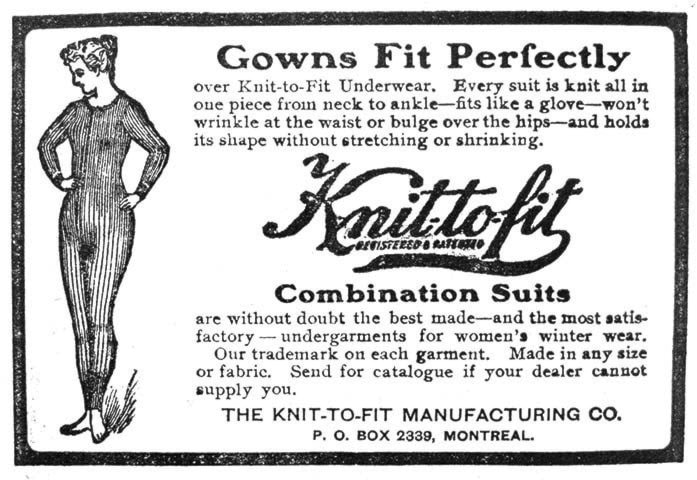Ah, Valentine's Day, that special day when true love comes to the fore.
When, if a gentleman properly understands the concept, a special gift, a token of admiration and affection is in order. Perhaps a box of the best chocolate, perhaps a dozen red roses, perhaps, should the degree of intimacy be such, some lingerie.
Not necessarily a problem for the discerning beau nowadays, somewhat trickier in the days of yore. Not the chocolate or roses, of course; neither has changed appreciably over the last century.
Lingerie, on the other hand ... well, for a gentleman to enter a dry goods store in the year 1900, and address the clerk behind the counter thusly: "I say, my good man, I am desirous of purchasing a gift for my best girl. Do you, by any chance, carry the Fairy Bust Form Corset — a new radical departure in shape and construction from any Bust Pull heretofore made, combining features of daintiness and the best ideas of a shapely and hygienic form permitting absolute freedom of movement? Or might you have on hand the Ferris Book of Living Models in order that I may choose the appropriate Ferris Bicycle Corset Waist constructed with elastic sides which yield to every motion of the wearer? The hips are short and pliable; the bust is made to give support without restriction. She will ride with easy grace because every motion, every muscle is absolutely free. She will ride without fatigue because she enjoys a perfect respiration. And where, might I ask, are the Valentine cards?"
Highly unlikely. Women's undergarments were rarely a subject of discussion in the early 20th century, perhaps wisely so, in terms of keeping things brief, as a woman of that era did not simply pop into a bra and thong, throw on a dress and shoes and hit the road.
In 1900, the well-tailored lady wore a significant variety of garments at a time, divided into four categories:
1) Undergarments — most commonly an "all-in-one" combination of chemise (undershirt/slip), "drawers" (underpants with legs, often split) and "stockings" (made of wool, cotton, or silk) which came up above the knee and were held in place with ribbon or elastic garters.
2) Foundation Garments — shoes (of course), generally of the thick heeled and pointed toe variety, and the ubiquitous corset. The corset gave "support" by forcing a woman's torso into the fashionable shape of the day. The bust was pushed up and the chest and backside pushed out by means of "boning" made of strips of whalebone or metal. It was important that the metal be of a good quality as it was considered poor form to rust in social settings. The corset hooked up at the front and laced up tightly and generally painfully at the back. (As an aside, women generally wore their hair high upon their heads. The popular style was often puffed out with the aid of "rats" made from hair saved from her hair brush and rolled between her hands to create small rat-like shapes.) Next was added the "corset-cover," made of lightweight cotton, in order to hide the corset. "Petticoats" (similar to slips and generally starched to avoid limpness) were added in desired layers to add to the fullness of the skirt.
3) Daily Garments — A floor-length, or sometimes ankle-length skirt of endless design and decoration, hopefully wide enough at the bottom to permit ease of walking or riding a bicycle. The upper torso was covered with a stand-up collared linen blouse known as a "shirt-waist", not unlike men's shirts of the period, and often stitched with embroidery. Accessories included a belt, pins, broaches, earrings and a locket.
4) Outer Garments — The hat (large or small, depending on the fashion), a parasol to avoid an unfashionable tan, handkerchief, purse and gloves.
And there you have it, a minimum of 22 articles later (not counting the rats or broach) until the magical words, "I'm ready, honey."
Of course, it is entirely unlikely that the average male of the day was aware of all this. Separate dressing-chambers were common, whereas easily decipherable descriptions of women's undergarments were not.
It seems it wasn't until the spring of 1904 that the first ad dealing which such things appeared in a Cranbrook newspaper. It stated "Ladies Muslin Underwear – the materials are the best used in underwear manufacture. The styles are beautiful, the variety unlimited and sizes complete." It was accompanied by an illustration of an attractive and shapely lady in long johns. It may have created a bit of a stir among the womenfolk as the following week the store replaced the ad with that of "little men's clothing for spring".
In fact, it was almost two years before another illustrated ladies underwear ad once more appeared and, true to form, it was a "Knit-To-Fit Combination Suit" — a one-piece from neck to ankle — in short, long underwear. Sparse times for males seeking titillation in advertising and certainly no help in shopping for that perfect lingerie gift.
The first local illustrated ad of an actual corset appeared in 1911, in truth, not so very long before the corset would begin to fall from fashion, brought about in no small part by the women's emancipation movement headed by such as Amelia Bloomer who herself popularized "bloomers," baggy pant-like apparel which became fashionable for decades.
By the end of the First World War the prevailing concept of ladies' undergarments was under much attack, with the corset as the ultimate target and women everywhere letting out collective sighs. By the 1920s it was all little more than an old-school novelty.
Is there a lesson in all this? Indeed, it reads: chocolates, roses and a nice restaurant.
janusthenandnow@shaw.ca
